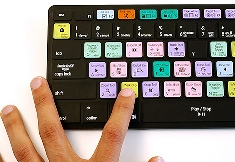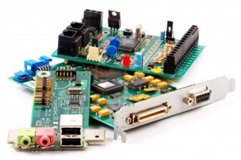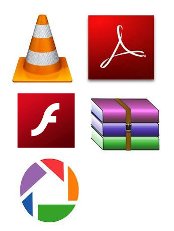

VCI
Stands for "Virtual Channel Identifier." The VCI, used in conjunction with the VPI (virtual path indicator), indicates where an ATM cell is to travel over a network. ATM, or asynchronous transfer mode, is a method that many ISPs (Internet Service Providers) use to transfer data to client computers. Because ATM sends packets over fixed channels, the data is easier to track than information sent over the standard TCP/IP protocol.
The VCI within each ATM cell defines the fixed channel on which the packet of information should be sent. It is a 16-bit field, compared to the VPI, which is only 8 bits. Since this numerical tag specifies the virtual channel that each packet belongs to, it prevents interference with other data being sent across the network.
VDU
A VDU is a Visual Display Unit. It is another term for monitor or screen, but may also refer to a projector or other type of display. VDUs may be peripheral devices or may be integrated into a computer system. While early VDUs were mainly CRT displays, today most monitors are flat panel displays that use LCD or LED technology.
Example: "A digital projector is often used as a VDU for PowerPoint presentations."
Vector
Mathematically, a vector is a quantity, defined by both magnitude and direction. For example, a vector could be illustrated by an 1 inch arrow pointing at a 30 degree angle. Another vector may be 2.5 inches and point at a 160 degree angle. In the computer world, vectors are used to define paths in certain types of images, such as EPS files and Adobe Illustrator documents. These images are often called vector graphics since they are comprised of vectors, or paths, instead of dots. Vector graphics can be scaled larger or smaller without losing quality.
In computer science, a vector may refer to a type of one dimensional array. For example, a vector called "fibonacci" that stores the first six values of the Fibonacci sequence would be defined as follows:
fibonacci[0] = 0, fibonacci[1] = 1, fibonacci[2] = 1, fibonacci[3] = 2, fibonacci[4] = 3, fibonacci[5] = 5
Vectors are similar to arrays, but unlike arrays, vectors use their own memory management mechanisms. Arrays are restricted to the memory structure supplied by the programming language they are created in, typically called a stack. Vectors have a more dynamic structure, often referred to as a heap, which gives them greater flexibility in how they use memory. While an array uses a static amount of memory, the memory used by the vector can be increased or decreased as elements are added or removed from the vector.
Vector Graphic
Unlike JPEGs, GIFs, and BMP images, vector graphics are not made up of a grid of pixels. Instead, vector graphics are comprised of paths, which are defined by a start and end point, along with other points, curves, and angles along the way. A path can be a line, a square, a triangle, or a curvy shape. These paths can be used to create simple drawings or complex diagrams. Paths are even used to define the characters of specific typefaces.
Because vector-based images are not made up of a specific number of dots, they can be scaled to a larger size and not lose any image quality. If you blow up a raster graphic, it will look blocky, or "pixelated." When you blow up a vector graphic, the edges of each object within the graphic stay smooth and clean. This makes vector graphics ideal for logos, which can be small enough to appear on a business card, but can also be scaled to fill a billboard. Common types of vector graphics include Adobe Illustrator, Macromedia Freehand, and EPS files. Many Flash animations also use vector graphics, since they scale better and typically take up less space than bitmap images.
VGA
Stands for "Video Graphics Array." It is the standard monitor or display interface used in most PCs. Therefore, if a montior is VGA-compatible, it should work with most new computers. The VGA standard was originally developed by IBM in 1987 and allowed for a display resolution of 640x480 pixels. Since then, many revisions of the standard have been introduced. The most common is Super VGA (SVGA), which allows for resolutions greater than 640x480, such as 800x600 or 1024x768. A standard VGA connection has 15 pins and is shaped like a trapezoid.
Virtual Memory
Memory is hardware that your computer uses to load the operating system and run programs. It consists of one or more RAM chips that each have several memory modules. The amount of real memory in a computer is limited to the amount of RAM installed. Common memory sizes are 256MB, 512MB, and 1GB.
Because your computer has a finite amount of RAM, it is possible to run out of memory when too many programs are running at one time. This is where virtual memory comes in. Virtual memory increases the available memory your computer has by enlarging the "address space," or places in memory where data can be stored. It does this by using hard disk space for additional memory allocation. However, since the hard drive is much slower than the RAM, data stored in virtual memory must be mapped back to real memory in order to be used.
The process of mapping data back and forth between the hard drive and the RAM takes longer than accessing it directly from the memory. This means that the more virtual memory is used, the more it will slow your computer down. While virtual memory enables your computer to run more programs than it could otherwise, it is best to have as much physical memory as possible. This allows your computer to run most programs directly from the RAM, avoiding the need to use virtual memory. Having more RAM means your computer works less, making it a faster, happier machine.
Virtualization
Virtualization allows a single computer to run multiple operating systems. For example, using virtualization software, a Mac OS X computer can run Windows and a Windows computer can run Linux. Virtualization software allows multiple operating systems to run at the same time and even interact with each other. When an additional operating system (OS) is running on top of the main OS through virtualization, it is called a virtual machine.
Example: "Virtualization allows a Macintosh computer to run Mac OS X and Windows at the same time."
Virus
Like a biological virus, a computer virus is something you don't want to get. Computer viruses are small programs or scripts that can negatively affect the health of your computer. These malicious little programs can create files, move files, erase files, consume your computer's memory, and cause your computer not to function correctly. Some viruses can duplicate themselves, attach themselves to programs, and travel across networks. In fact opening an infected e-mail attachment is the most common way to get a virus.
We all know it's hard enough to get a computer to work well when it is healthy, let alone when it has been attacked by a virus. Therefore, it is better to prevent an attack than to try and cure it. There are many antivirus programs available that scan incoming files for viruses before they can cause damage to your computer. Some of these programs include Norton AntiVirus, McAfee VirusScan, and Virex. It is a good idea to have one of these programs on your computer to prevent a virus attack. It is also important to update your virus definitions file at least once a month so that your anti-virus program can check for all the latest viruses.
Visual Basic
Visual Basic is a programming language and development environment created by Microsoft. It is an extension of the BASIC programming language that combines BASIC functions and commands with visual controls. Visual Basic provides a graphical user interface GUI that allows the developer to drag and drop objects into the program as well as manually write program code.
Visual Basic, also referred to as "VB," is designed to make software development easy and efficient, while still being powerful enough to create advanced programs. For example, the Visual Basic language is designed to be "human readable," which means the source code can be understood without requiring lots of comments. The Visual Basic program also includes features like "IntelliSense" and "Code Snippets," which automatically generate code for visual objects added by the programmer. Another feature, called "AutoCorrect," can debug the code while the program is running.
Programs created with Visual Basic can be designed to run on Windows, on the Web, within Office applications, or on mobile devices. Visual Studio, the most comprehensive VB development environment, or IDE, can be used to create programs for all these mediums. Visual Studio .NET provides development tools to create programs based on the .NET framework, such as ASP.NET applications, which are often deployed on the Web. Finally, Visual Basic is available as a streamlined application that is used primarily by beginning developers and for educational purposes.
VoIP
Stands for "Voice Over Internet Protocol," and is often pronounced "voip." VoIP is basically a telephone connection over the Internet. The data is sent digitally, using the Internet Protocol (IP) instead of analog telephone lines. This allows people to talk to one another long-distance and around the world without having to pay long distance or international phone charges.
In order to use VoIP, you need a computer, an Internet connection, and VoIP software. You also need either a microphone, analog telephone adapter, or VoIP telephone. Many VoIP programs allow you to use a basic microphone and speaker setup. Others requires VoIP phones, which are like regular telephone handsets, but typically connect to your computer via USB. Analog telephone adapters allow you to use regular phones with your computer. IP phones are another option that connect directly to a router via Ethernet or wirelessly. These phones have all the necessary software for VoIP built in and therefore do not require a computer.
The largest provider of VoIP services is Vonage, but there are several other companies that offer similar services. While Vonage charges a monthly service fee, programs like Skype and PeerMe allow users to connect to each other and talk for free. However, these free services may offer fewer connections, lower audio quality, and may be less reliable than paid services like Vonage.
VPI
Stands for "Virtual Path Identifier." The VPI is an 8-bit header inside each ATM cell that indicates where the cell should be routed. ATM, or asynchronous transfer mode, is a method of sending data in small packets of fixed sizes. It is used by many ISPs (Internet Service Providers) for transferring data to client computers.
As an ATM cell moves across a network, it typically passes through several ATM switches. The VPI tells the switches where to route the packet of information, or what path to take. Hence the name, "virtual path identifier." The VPI is used in conjunction with the VCI, or virtual channel identifier.
VPN
Stands for "Virtual Private Network" (not a successor to the UPN television network). VPN is a network term that most computer users don't need to know, but at least you can impress your friends by talking about it. A virtual private network is "tunneled" through a wide area network WAN such as the Internet. This means the network does not have to be located in one physical location like a LAN. However, by using encryption and other security measures, a VPN can scramble all the data sent through the wide area network, so the network is "virtually" private.
Businesses often use VPNs to communicate across multiple locations. For example, a large company that has offices in several cities may need to send data to the different locations via the Internet. To keep the information secure, the company might set up a VPN with an encrypted connection. This is similar to having a secure intranet over the Internet. On a smaller scale, individual users may have a VPN account with their company, which allows them to connect to their office computer from their home or another location. This is especially helpful for business travelers who need to access office data from their laptops.
VRAM
Stands for "Video Random Access Memory" and is pronounced "V-RAM." System RAM is great for loading and running programs, but when you need graphics power, VRAM is where it's at. This is the memory used to store image data that the computer displays; it acts as a buffer between the CPU and the video card. When a picture is to be displayed on the screen, the image is first read by the processor and then written to the VRAM. The data is then converted by a RAM digital-to-analog converter (RAMDAC) into analog signals that are sent to the display. Of course, the whole process happens so quickly, you don't notice it. Unlike most system RAM, VRAM chips are dual-ported, which means that while the display is reading from VRAM to refresh the currently displayed image, the processor is writing a new image to the VRAM. This prevents the display from flickering between the redrawing of images.
There are many different types of VRAM. One popular kind is called Synchronous Graphics RAM (SGRAM). It is an inexpensive type of RAM that is clock-synchronized. This means data can be modified in a single operation rather than as a sequence of read, write, and update operations. This allows background, foreground, and image fills to be handled more efficiently. Another type of VRAM is Rambus Dynamic RAM (RDRAM). It is designed by Rambus and includes a proprietary Rambus bus that speeds up the transfer of data through it. Video editing pros like this chip since it is optimized for video streaming. A third type of VRAM is Window RAM (WRAM). This high-performance VRAM is dual-ported, has about 25% more bandwidth than standard VRAM, and typically costs less. Finally, there is Multibank Dynamic RAM (MDRAM). This is also high-performance VRAM, developed by MoSys, which divides the memory into divisions of 32 KB that can be accessed individually. This makes memory transfers more efficient and increases overall performance. Another advantage of MDRAM is that it can be manufactured with just the right amount of memory for a given resolution, so it is cheaper to manufacture than most other types of VRAM.

| Terms |
| VCI |
| VDU |
| Vector |
| Vector Graphic |
| VGA |
| Virtual Memory |
| Virtualization |
| Virus |
| Visual Basic |
| VoIP |
| VPI |
| VPN |
| VRAM |
| Web Pages by Students |
ABC of C Language by Shailender Sharma |
Bootable Pen Drive by Avtar Singh |
e-Trash or e-Treasure? by Pallavi Bagga |
Lakshya by Rabina Bagga |
OOPs Concepts by Navjot Kaur |
Fitness First by Ankush Rathore |
Information Systems by Kajal Gupta |
Quiz Contest in C++ by Rajnish Kumar |
Core Java (Tutorial) by Shyena |
C Language Q&A by Anmol Sharma |
HTML 5 Tutorial by Kishan Verma |








